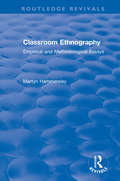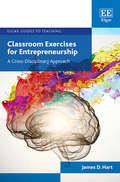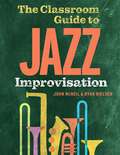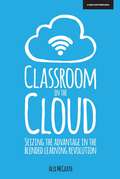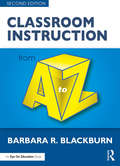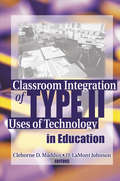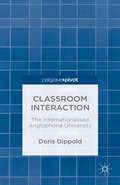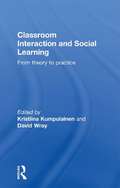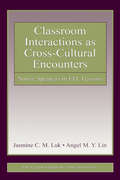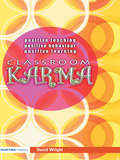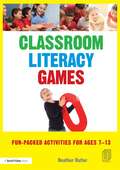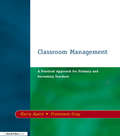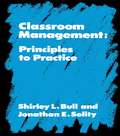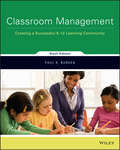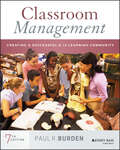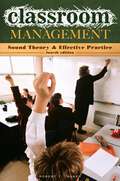- Table View
- List View
Classroom Ethnography: Empirical and Methodological Essays
by Martyn HammersleyOriginally published in 1990, Classroom Ethnography examines the interplay between empirical research and methodological reflection. It explores the nature, the methods, the role, and the limitations of ethnographic research on school classrooms. Beginning with examples of Hammersley’s empirical research, the book then moves on to a number of reflections about the methodology of ethnographic research, covering such matters as the role of theory and the relative contributions of qualitative and quantitative work. Classroom Ethnography will be of use to those with an interest in educational research methodology and, in particular, of ethnographic research on classrooms.
Classroom Exercises for Entrepreneurship: A Cross-Disciplinary Approach (Elgar Guides to Teaching)
by James D. HartEntrepreneurship is a creative practice with tremendous impact, but how does one effectively teach entrepreneurs to engage in this sometimes tumultuous and risk-laden process? A traditional stand and lecture approach to teaching this complex subject does not always suffice, and many professors are finding that students benefit more from hands-on experiences. By engaging and acting, students can own their knowledge and progress beyond an intellectual understanding of the subject. This book offers sixty-five experiential exercises, each designed to be applicable to the entrepreneurial process. These cross-disciplinary exercises vary in scale from single-class activities to course projects or yearlong capstones. Learning objectives are clearly defined so that instructors can incorporate the book’s exercises, games, simulations and demonstrations into their syllabi. Whether classes are basic, intermediate or advanced, instructors can use the exercises to engage their students and help them develop as creatively-minded entrepreneurs. Entrepreneurship professors seeking experiential exercises to incorporate into their teaching will find this book of value.
The Classroom Guide to Jazz Improvisation
by John McNeil Ryan NielsenYou don't have to be a jazz expert to give your students a great introduction to improvisation. The Classroom Guide to Jazz Improvisation provides what music educators have sought for decades: an easy, step-by-step guide to teaching jazz improvisation in the music classroom. Offering classroom-tested lesson plans, authors John McNeil and Ryan Nielsen draw on their combined 54 years of teaching experience and extensive work as professional jazz musicians to remove the guesswork and mystique from the teaching process. Each lesson is founded in the authors' realization that the brain responds differently to improvisation than it does rote memory. The resulting lesson plans are flexible, easy to use, and equip students with a quick understanding of the simple choices they can make to create effective jazz lines. Lessons are designed for a range of settings, from ensemble rehearsal to private instruction. Music educators may find relief in the concrete, straightforward materials on rhythm section instruments like bass, drums, piano, and guitar. Beyond the nuts and bolts of improvisation, this book contains carefully curated listening lists, honest discussions about the meaning of the music, and talking points to advocate for jazz programs to administrators and parents. With an inviting and conversational approach, The Classroom Guide to Jazz Improvisation is an essential resource for all music educators, from early career teachers to seasoned instructors.
The Classroom Guide to Jazz Improvisation
by John McNeil Ryan NielsenYou don't have to be a jazz expert to give your students a great introduction to improvisation. The Classroom Guide to Jazz Improvisation provides what music educators have sought for decades: an easy, step-by-step guide to teaching jazz improvisation in the music classroom. Offering classroom-tested lesson plans, authors John McNeil and Ryan Nielsen draw on their combined 54 years of teaching experience and extensive work as professional jazz musicians to remove the guesswork and mystique from the teaching process. Each lesson is founded in the authors' realization that the brain responds differently to improvisation than it does rote memory. The resulting lesson plans are flexible, easy to use, and equip students with a quick understanding of the simple choices they can make to create effective jazz lines. Lessons are designed for a range of settings, from ensemble rehearsal to private instruction. Music educators may find relief in the concrete, straightforward materials on rhythm section instruments like bass, drums, piano, and guitar. Beyond the nuts and bolts of improvisation, this book contains carefully curated listening lists, honest discussions about the meaning of the music, and talking points to advocate for jazz programs to administrators and parents. With an inviting and conversational approach, The Classroom Guide to Jazz Improvisation is an essential resource for all music educators, from early career teachers to seasoned instructors.
Classroom in the Cloud: Seizing The Advantage In The Blended Learning Revolution
by Alex McGrathThis book aims to focus the minds of teachers and school leaders to take advantage of the opportunities presented by the online revolution and the emergence of blended learning. The author, who is Head of King's Ely Senior, argues that with planning and co-ordination, huge benefits can be reaped from new ways of learning, complementing the traditions of British education. He looks at the implications for the UK of e-learning practices and techniques that have been introduced overseas and urges teachers and leaders to face the challenges posed by new technology and embrace change.
Classroom Instruction from A to Z (A to Z Series)
by Barbara R. BlackburnLearn the most effective ways to promote student learning. This second edition of bestselling author Barbara Blackburn’s Classroom Instruction from A to Z covers a broad range of key instructional strategies to help you create more meaningful, engaging learning experiences for your students. Each chapter from A to Z offers guidance on a specific aspect of classroom instruction, such as planning strong lessons; assessing student learning; creating more successful homework assignments; differentiating instruction; and scaffolding students for success. Throughout the book, you’ll find practical strategies and tools that you can implement immediately, no matter what subject area or grade level you teach. Topics new to this updated edition include: Exploring blended learning techniques such as flipped classrooms; Strategies for implementing social emotional learning and mindfulness; Understanding diverse learners and accommodating all students; Teaching academic vocabulary in deeper ways; and Integrating subjects and promoting writing across the curriculum. With twenty-six chapters each devoted to a different aspect of instruction, this book has something to offer both new and experienced looking to improve student learning. Additionally, classroom-ready tools are available as free eResources from our website, http://www.routledge.com/9781138935952.
Classroom Instruction from A to Z (A to Z Series)
by Barbara R. BlackburnLearn the most effective ways to promote student learning. This second edition of bestselling author Barbara Blackburn’s Classroom Instruction from A to Z covers a broad range of key instructional strategies to help you create more meaningful, engaging learning experiences for your students. Each chapter from A to Z offers guidance on a specific aspect of classroom instruction, such as planning strong lessons; assessing student learning; creating more successful homework assignments; differentiating instruction; and scaffolding students for success. Throughout the book, you’ll find practical strategies and tools that you can implement immediately, no matter what subject area or grade level you teach. Topics new to this updated edition include: Exploring blended learning techniques such as flipped classrooms; Strategies for implementing social emotional learning and mindfulness; Understanding diverse learners and accommodating all students; Teaching academic vocabulary in deeper ways; and Integrating subjects and promoting writing across the curriculum. With twenty-six chapters each devoted to a different aspect of instruction, this book has something to offer both new and experienced looking to improve student learning. Additionally, classroom-ready tools are available as free eResources from our website, http://www.routledge.com/9781138935952.
Classroom Integration of Type II Uses of Technology in Education
by Cleborne D MadduxDevelop new strategies for using computers in the classroomEducators have talked about using information technology to improve teaching since the beginning of the modern computer movement but true integration remains an elusive goal-for most. Classroom Integration of Type II Uses of Technology in Education finds teachers who have managed to take advantage of the sophistication, power, and affordability of today&’s technology to develop new and better strategies for learning, despite the absence of an effective institutional infrastructure. This unique book reviews effective Type II teaching applications and software used at all educational levels, including Lego/Logo technologies, idea technologies, graphics software, laptop computers, and handheld computers. Information technology in schools has failed to fulfill its considerable potential because without a widespread instructional support system, computers are generally poorly used and not integrated meaningfully into classroom activities. But some educators have still been able to implement Type II applications of information technology in their educational settings. Classroom Integration of Type II Uses of Technology in Education looks at their innovative methods of using computers to bring about more effective teaching-and learning.Classroom Integration of Type II Uses of Technology in Education examines: computer activities of grade 1-5 students using Lego/Logo technologies using Kid-Pix graphics software for creative activities the Technology Integration Assessment Instrument (TIAI) gender disparity in computer-oriented problem solving a three-tiered, idea-technology classification system pre-service teacher preparation assistive technology definitions, legislation, and implementation issues lesson plans and document techniques for laptop computers an action/instructional model for using handheld wireless computers in the classroom Classroom Integration of Type II Uses of Technology in Education is an invaluable resource for academics working in information technology and education, and for K-12 teachers and administrators at all levels.
Classroom Integration of Type II Uses of Technology in Education
by Cleborne D MadduxDevelop new strategies for using computers in the classroomEducators have talked about using information technology to improve teaching since the beginning of the modern computer movement but true integration remains an elusive goal-for most. Classroom Integration of Type II Uses of Technology in Education finds teachers who have managed to take advantage of the sophistication, power, and affordability of today&’s technology to develop new and better strategies for learning, despite the absence of an effective institutional infrastructure. This unique book reviews effective Type II teaching applications and software used at all educational levels, including Lego/Logo technologies, idea technologies, graphics software, laptop computers, and handheld computers. Information technology in schools has failed to fulfill its considerable potential because without a widespread instructional support system, computers are generally poorly used and not integrated meaningfully into classroom activities. But some educators have still been able to implement Type II applications of information technology in their educational settings. Classroom Integration of Type II Uses of Technology in Education looks at their innovative methods of using computers to bring about more effective teaching-and learning.Classroom Integration of Type II Uses of Technology in Education examines: computer activities of grade 1-5 students using Lego/Logo technologies using Kid-Pix graphics software for creative activities the Technology Integration Assessment Instrument (TIAI) gender disparity in computer-oriented problem solving a three-tiered, idea-technology classification system pre-service teacher preparation assistive technology definitions, legislation, and implementation issues lesson plans and document techniques for laptop computers an action/instructional model for using handheld wireless computers in the classroom Classroom Integration of Type II Uses of Technology in Education is an invaluable resource for academics working in information technology and education, and for K-12 teachers and administrators at all levels.
Classroom Interaction: The Internationalised Anglophone University
by Doris DippoldInternationalisation has had a forceful impact on universities across the Anglophone world. This book reviews what we know about interaction in the Anglophone university classroom, describes the challenges students and tutors face, and illustrates how they can overcome these challenges by drawing on their own experiences and practices.
Classroom Interactions and Social Learning: From Theory to Practice
by Kristiina Kumpulainen David WrayToday's classroom presents a wealth of opportunities for social interaction amongst pupils, leading to increased interest in teachers and researchers into the social nature of learning.While classroom interaction can be a valuable tool for learning, it does not necessarily lead to useful learning experiences. Through case studies, this book highlights the use of new analytical methodologies for studying the content and patterns of children's interactions and how these contribute to their construction of knowledge.Classroom Interaction and Social Learning will be of interest to students and in service teachers and researchers concerned with classroom discourse and learning.
Classroom Interactions and Social Learning: From Theory to Practice
by Kristiina Kumpulainen David WrayToday's classroom presents a wealth of opportunities for social interaction amongst pupils, leading to increased interest in teachers and researchers into the social nature of learning.While classroom interaction can be a valuable tool for learning, it does not necessarily lead to useful learning experiences. Through case studies, this book highlights the use of new analytical methodologies for studying the content and patterns of children's interactions and how these contribute to their construction of knowledge.Classroom Interaction and Social Learning will be of interest to students and in service teachers and researchers concerned with classroom discourse and learning.
Classroom Interactions as Cross-Cultural Encounters: Native Speakers in EFL Lessons (ESL & Applied Linguistics Professional Series)
by Jasmine C. Luk Angel M. LinClassroom Interactions as Cross-Cultural Encounters is about native English speakers teaching English as a global language in non-English speaking countries. Through analysis of naturally occurring dialogic encounters, the authors examine the multifaceted ways in which teachers and students utilize diverse communicative resources to construct, display, and negotiate their identities as teachers, learners, and language users, with different pedagogic, institutional, social, and political implications. A range of issues in applied linguistics is addressed, including linguistic imperialism, post-colonial theories, micropolitics of classroom interaction, language and identity, and bilingual classroom practices. Intended to help TESOL professionals of different cultural backgrounds, working in different sociocultural contexts, to critically understand how non-assimilationist, dialogic intercultultural communication with students can be achieved and built on for mutual cultural and linguistic enrichment and empowerment, this book:*emphasizes the sociocultural meanings and micropolitics of classroom interactions that reveal the complex realities of power and identity negotiations in cross-cultural interactions in ELT (English Language Teaching) classroom contexts;*revisits and reconstitutes the notion of native-speakerness and repositions the roles of native and non-native English teachers in the TESOL profession in the contexts of decolonization and globalization; *highlights the need to mobilize intercultural communicative resources for global communication;*addresses two major concerns of EFL (English as a Foreign Language) classroom researchers and teachers: student resistance and learning motivation; and*examines and analyzes the changing ideologies (both explicit and implicit) of teachers and students about English learning in the context of a post-colonial society, and how these ideologies are being enacted, reproduced, but also sometimes contested in EFL classroom interactions. Each chapter includes Questions for Reflection and Discussion to promote critical thinking and understanding of the issues discussed. Tuning-In discussion questions are provided in the three chapters on classroom data analysis to activate readers interpretive schemas before they examine the actual classroom episodes. The data are from an ethnographic study in post-colonial Hong Kong secondary schools involving four native English-speaker teachers and two bilingual Cantonese-English speaking teachers engaged in intercultural classroom dialogues with their Cantonese Hong Kong students. The rich, naturally occurring classroom data and in-depth analyses provide useful pedagogical materials for courses in EFL teacher education programs on classroom discourse analysis from sociocultural perspectives.
Classroom Interactions as Cross-Cultural Encounters: Native Speakers in EFL Lessons (ESL & Applied Linguistics Professional Series)
by Jasmine C. Luk Angel M. LinClassroom Interactions as Cross-Cultural Encounters is about native English speakers teaching English as a global language in non-English speaking countries. Through analysis of naturally occurring dialogic encounters, the authors examine the multifaceted ways in which teachers and students utilize diverse communicative resources to construct, display, and negotiate their identities as teachers, learners, and language users, with different pedagogic, institutional, social, and political implications. A range of issues in applied linguistics is addressed, including linguistic imperialism, post-colonial theories, micropolitics of classroom interaction, language and identity, and bilingual classroom practices. Intended to help TESOL professionals of different cultural backgrounds, working in different sociocultural contexts, to critically understand how non-assimilationist, dialogic intercultultural communication with students can be achieved and built on for mutual cultural and linguistic enrichment and empowerment, this book:*emphasizes the sociocultural meanings and micropolitics of classroom interactions that reveal the complex realities of power and identity negotiations in cross-cultural interactions in ELT (English Language Teaching) classroom contexts;*revisits and reconstitutes the notion of native-speakerness and repositions the roles of native and non-native English teachers in the TESOL profession in the contexts of decolonization and globalization; *highlights the need to mobilize intercultural communicative resources for global communication;*addresses two major concerns of EFL (English as a Foreign Language) classroom researchers and teachers: student resistance and learning motivation; and*examines and analyzes the changing ideologies (both explicit and implicit) of teachers and students about English learning in the context of a post-colonial society, and how these ideologies are being enacted, reproduced, but also sometimes contested in EFL classroom interactions. Each chapter includes Questions for Reflection and Discussion to promote critical thinking and understanding of the issues discussed. Tuning-In discussion questions are provided in the three chapters on classroom data analysis to activate readers interpretive schemas before they examine the actual classroom episodes. The data are from an ethnographic study in post-colonial Hong Kong secondary schools involving four native English-speaker teachers and two bilingual Cantonese-English speaking teachers engaged in intercultural classroom dialogues with their Cantonese Hong Kong students. The rich, naturally occurring classroom data and in-depth analyses provide useful pedagogical materials for courses in EFL teacher education programs on classroom discourse analysis from sociocultural perspectives.
Classroom Karma: Positive Teaching, Positive Behaviour, Positive Learning
by David WrightA positive and calm classroom environment enriches the teaching and learning experience for teachers and children alike. Using his invaluable experience working in pupil referral units and as a head teacher, David Wright shows how the ideal primary classroom environment can be achieved through many useful practical ideas and suggestions. Backed by up-to-date research on how we learn and how best to teach, the clear and concise chapters cover broad teaching skills including: how to create a positive learning environment where pupils feel valued, prepared to leave their 'comfort zone', and willing to ask questions understanding what effects certain aspects of your behaviour can have on children behaviour management strategies that allow the children to take responsibility for their actions making the most of colleagues, parents and your community to provide memorable learning experiences. Written by a teacher for teachers, Classroom Karma is essential reading for all those looking to establish a successful learning environment where pupils feel valued and motivated in the primary classroom and beyond.
Classroom Karma: Positive Teaching, Positive Behaviour, Positive Learning
by David WrightA positive and calm classroom environment enriches the teaching and learning experience for teachers and children alike. Using his invaluable experience working in pupil referral units and as a head teacher, David Wright shows how the ideal primary classroom environment can be achieved through many useful practical ideas and suggestions. Backed by up-to-date research on how we learn and how best to teach, the clear and concise chapters cover broad teaching skills including: how to create a positive learning environment where pupils feel valued, prepared to leave their 'comfort zone', and willing to ask questions understanding what effects certain aspects of your behaviour can have on children behaviour management strategies that allow the children to take responsibility for their actions making the most of colleagues, parents and your community to provide memorable learning experiences. Written by a teacher for teachers, Classroom Karma is essential reading for all those looking to establish a successful learning environment where pupils feel valued and motivated in the primary classroom and beyond.
Classroom Literacy Games: Fun-packed activities for ages 7-13
by Heather ButlerChildren enjoyed it so much they didn’t realise they were being worked so hard.Jo Miles, Learning Support Assistant at Manor Farm Community Junior School, Hazlemere, Buckinghamshire Great speaking and listening activity-setting-up ideas for the Big Write. The games extended the children’s vocabulary. Purposeful learning – love it!Liz Pilgrim, Senior Teacher at Manor Farm Community Junior School, Hazlemere, Buckinghamshire Educational games played in groups or pairs help develop key language and social skills. Based on a range of material to extend vocabulary, punctuation and cross-curricular creativity, Classroom Literacy Games contains original games with suggestions of how to develop writing tasks after playing them. Each game is differentiated four ways and aims to teach literacy (including vocabularly, connectives, openers and punctuation) to higher KS1, KS2 and lower KS3. Printed with dyslexia-friendly fonts, these cross-curricular games are suitable for mixed-ability classrooms, small groups or one-to-one teaching situations. As either photocopiable resources to be used in the classroom or as homework activities, these games will create situations to generate creative writing and for the children to create their own games. They can also be used for EAL, guided reading and weekly Big Write exercises. With minimal preparation time required and a vast number of games, these user-friendly, pick-up-and-go activities will be of interest to any practicing primary and lower KS3 teacher.
Classroom Literacy Games: Fun-packed activities for ages 7-13
by Heather ButlerChildren enjoyed it so much they didn’t realise they were being worked so hard.Jo Miles, Learning Support Assistant at Manor Farm Community Junior School, Hazlemere, Buckinghamshire Great speaking and listening activity-setting-up ideas for the Big Write. The games extended the children’s vocabulary. Purposeful learning – love it!Liz Pilgrim, Senior Teacher at Manor Farm Community Junior School, Hazlemere, Buckinghamshire Educational games played in groups or pairs help develop key language and social skills. Based on a range of material to extend vocabulary, punctuation and cross-curricular creativity, Classroom Literacy Games contains original games with suggestions of how to develop writing tasks after playing them. Each game is differentiated four ways and aims to teach literacy (including vocabularly, connectives, openers and punctuation) to higher KS1, KS2 and lower KS3. Printed with dyslexia-friendly fonts, these cross-curricular games are suitable for mixed-ability classrooms, small groups or one-to-one teaching situations. As either photocopiable resources to be used in the classroom or as homework activities, these games will create situations to generate creative writing and for the children to create their own games. They can also be used for EAL, guided reading and weekly Big Write exercises. With minimal preparation time required and a vast number of games, these user-friendly, pick-up-and-go activities will be of interest to any practicing primary and lower KS3 teacher.
Classroom Management: A Practical Approach for Primary and Secondary Teachers
by Harry Ayers Francesca GrayFirst Published in 1998. Routledge is an imprint of Taylor & Francis, an informa company.
Classroom Management: A Practical Approach for Primary and Secondary Teachers
by Harry Ayers Francesca GrayFirst Published in 1998. Routledge is an imprint of Taylor & Francis, an informa company.
Classroom Management: Principles to Practice
by Shirley Bull Phillip Feldman Jonathan SolityHow to manage a class is probably the major worry of all teachers in training and young teachers new to the job. This book shows how psychological principles, strategies and tools can be applied to improve classroom practice.
Classroom Management: Principles to Practice
by Shirley Bull Phillip Feldman Jonathan SolityHow to manage a class is probably the major worry of all teachers in training and young teachers new to the job. This book shows how psychological principles, strategies and tools can be applied to improve classroom practice.
Classroom Management: Creating a Successful K-12 Learning Community
by Paul BurdenA practical guide to what can be accomplished utilizing the technical aspects of Classroom Management, this invaluable resource will not only help educators learn how to build positive classroom communities, but also outline methods for involving students in the creation of their learning environment. The Sixth Edition has been updated to include a new chapter on communication skills for teaching, incorporated classroom case studies in each chapter, and includes updates using the latest management research in several chapters.
Classroom Management: Sound Theory and Effective Practice
by Robert T. TauberEducators need a balance between discipline theory and its practice in the classroom. This is especially important in today's educational climate, with its increased demands for teacher accountability. Tauber has designed this book for both those who are new to teaching and those who are already seasoned teachers but who have had little, if any, coursework in discipline. This book presents several sound frameworks that readers can use to evaluate six tried-and-true discipline models. Teachers need to select, learn, and implement a discipline model that best reflects how they feel students should be treated. Tauber explores a number of topics, some controversial, all quite relevant, concerning how teachers can prevent, as well as handle, problem behaviors. A chapter describing A through Z discipline suggestions can be immediately put into use.
